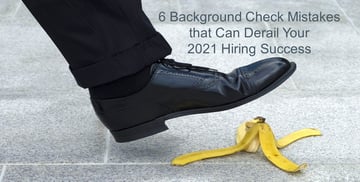Disclaimer: The following article is not offered as business or legal advice. Data Facts is not a law firm and does not offer legal or business consulting advice. This article is not intended as a substitute for the legal advice of an attorney knowledgeable of the issues covered as they relate to a user’s individual circumstances.

Do your folders, whether paper or digital, look like something you might see on an episode of “Hoarders”? Do you know you need to clean them out, but you don’t know where to begin? Then you’re at the right place.
It’s intimidating deciding which hiring docs you need to hang on to and which ones to trash. After all, there’s that fear of “what if I need ‘em” permeating every toss. It’s enough to cause you to give up and shove them all back into folders to clog your files for eternity.
Here’s a clear-cut plan to effectively spring clean you hiring docs without worrying about ditching something valuable.
What Can You Throw Away?
Employers maintain multiple files on every job applicant and employee. These all may contain personal identifying information (PII) that could be damaging if identity thieves snag it.
There are numerous documents involved in the hiring process. The job ads, resumes, applications, interview notes, signed authorizations, background check report, results of physical examinations, employment test results, tests used in the selection process, and related information fall into this category. Employers are required to maintain this information for candidates whether or not they ended up being hired.
The best way to choose which hiring docs can hit the dumpster without worrying about trashing something important is to follow these best practices.
- 1 YEAR. EEOC regulations require that employers keep all personnel or employment records for one year. If an employee is involuntarily terminated, his/her personnel records must be retained for one year from the date of termination. Keep hiring notes, resumes, applications, and job descriptions for every applicant once the job is filled. If it takes 6 weeks to fill the position, start your count once the job is filled, not when you began looking.
- 3 YEARS. Under the Age Discrimination in Employment Act (ADEA) recording requirements, employers must keep all payroll records for three years.
- 3 YEARS/1 YEAR. With I-9 forms, it’s a “whichever is later” rule as regulated by the U.S. Citizenship and Immigration Services (USCIS) rule. Employers are required to store them for either 3 years after the employee is hired, or for one year after the employee is terminated.
Example: In January 2015, Ted and Sarah are hired. Sarah is a great employee, but Ted isn’t. He gets canned 2 1/2 years after he’s hired, in the middle of 2017. Employers must keep Sarah’s I-9 form until the beginning of 2018. Ted’s I-9 form must be kept until the middle of 2018, which is one year after he was terminated.
(This rule is confusing, which is why many employers choose to use an automated I-9 solution that offers a purge feature.)
- 2 YEARS/5 YEARS. Background check reports are other pieces of information that employers should keep for time period that’s in compliance with the FCRA’s statute of limitations. An individual must make a claim regarding a violation of their rights within two years after learning about the violation. If the violation is not discovered within five years of the violation date, then the statute bars an action.
Example: There is an FCRA violation against Lisa on August 1, 2014. The violation goes undetected. A claim for this violation must be brought before August 1, 2019 or the statute will prevent the claim. If however, the violation is detected on June 1, 2015, the violation must be brought by June 1, 2017 or the statute will prevent the claim.
A smart best practice is to keep all background screening report documents for 5 years. Data Facts requires our clients to keep these records for 5 years. (Please follow your specific industry’s guidelines on the length of time to hold on to these documents.)
- 6 YEARS. The Employment Retirement Income Security Act (ERISA) Section 107 states that plan records used to support filings be retained for 6 years. Documents like copies of the Form 5500 (including all required schedules and attachments), nondiscrimination and coverage test results, required employee communications, financial reports and supporting documentation, evidence of the plan’s fidelity bond, and corporate income-tax returns (to reconcile deductions). Employers should maintain records of all pension benefit plans as well.
HOW Can You Toss ‘Em?
When feeling the urge to purge, it’s an employer’s responsibility to practice responsible document destruction. After all, one person’s trash is another one’s…gateway to identity theft.
Shred, shred shred! Make a policy that clearly defines hiring docs must be shredded entirely before disposal. Train every assistant, or anyone else involved in disposing of the information, on the importance of adhering to these rules every time, at all times.
Delete, delete, purge. If the documents are filed electronically, ask you IT manager how to dispose of them so they can’t be accessed or reconstructed. Make sure that, if you want them gone, they are truly gone.
If you need to clean out your files, whether they are physical, electronic, or both, don’t delay. Simply purge with caution. By using thoughtful consideration and adhering to the rules set by the ADEA, USCIS, FCRA, ERISA, and EEOC, you can spring clean your hiring docs without fear of tossing something you might need down the road.
Other posts you might be interested in
View All Posts
Know Which Hiring Documents to Keep and Which to Purge
Read More
5 Background Check Mistakes that Can Derail Your 2021 Hiring Success
Read More
